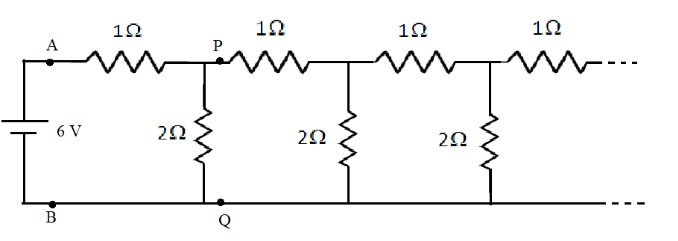
An infinite ladder network of resistances is constructed with \[1\,\Omega \] and \[2\,\Omega \] resistances as shown in the figure. The 6 V battery between A and B has negligible internal resistance. The equivalent resistance between A and B is?


Answer
476.1k+ views
Hint:: Assume the equivalent resistance of the circuit beyond the first loop of the circuit as R, then find the equivalent resistance of the whole network.
Formula used:
The equivalent resistance of the parallel combination of resistors \[{R_1}\] and \[{R_2}\]:
\[{R_{12}} = \dfrac{{{R_1}{R_2}}}{{{R_1} + {R_2}}}\]
The equivalent resistance of the series combination of resistors \[{R_1}\] and \[{R_2}\]:
\[{R_{12}} = {R_1} + {R_2}\]
Complete step by step answer:
The above circuit diagram of infinite ladder network is,

Let the equivalent resistance of the above circuit is R. Since the circuit is infinitely long, removing the loop ABDC from the circuit will not affect the equivalent resistance of the circuit. Therefore, the equivalent resistance of the circuit beyond PQ is also R.
Now, the revised circuit diagram for this case will become,

In the above circuit diagram, the resistors R and \[2\,\Omega \] are in parallel combination to each other. The equivalent resistance of these two is,
\[{R_1} = \dfrac{{\left( R \right)\left( {2\,} \right)}}{{R + 2\,}}\]
\[ \Rightarrow {R_1} = \dfrac{{2R}}{{R + 2}}\]
Now, \[{R_1}\] is in series with \[1\,\Omega \] resistance of the first loop and we know that the equivalent resistance of these two resistors is R. therefore,
\[R = \dfrac{{2R}}{{R + 2}} + 1\]
\[ \Rightarrow R\left( {R + 2} \right) = 2R + \left( {R + 2} \right)\]
\[ \Rightarrow {R^2} - R + 2 = 0\]
Solve this second order equation to get the value of equivalent resistance as follows,
\[R = \dfrac{{1 \pm \sqrt {{1^2} + 4\left( 2 \right)} }}{2}\]
\[\therefore R = + 2\,\,{\text{or}}\, - 2\]
But resistance can never be negative. Therefore, the equivalent resistance of the circuit is \[2\,\Omega \].
Note: We cannot find the equivalent resistance of the infinite ladder network by determining the equivalent resistance of each loop in the circuit. Always assume the equivalent resistance of the network excluding the first loop as R.
Formula used:
The equivalent resistance of the parallel combination of resistors \[{R_1}\] and \[{R_2}\]:
\[{R_{12}} = \dfrac{{{R_1}{R_2}}}{{{R_1} + {R_2}}}\]
The equivalent resistance of the series combination of resistors \[{R_1}\] and \[{R_2}\]:
\[{R_{12}} = {R_1} + {R_2}\]
Complete step by step answer:
The above circuit diagram of infinite ladder network is,

Let the equivalent resistance of the above circuit is R. Since the circuit is infinitely long, removing the loop ABDC from the circuit will not affect the equivalent resistance of the circuit. Therefore, the equivalent resistance of the circuit beyond PQ is also R.
Now, the revised circuit diagram for this case will become,

In the above circuit diagram, the resistors R and \[2\,\Omega \] are in parallel combination to each other. The equivalent resistance of these two is,
\[{R_1} = \dfrac{{\left( R \right)\left( {2\,} \right)}}{{R + 2\,}}\]
\[ \Rightarrow {R_1} = \dfrac{{2R}}{{R + 2}}\]
Now, \[{R_1}\] is in series with \[1\,\Omega \] resistance of the first loop and we know that the equivalent resistance of these two resistors is R. therefore,
\[R = \dfrac{{2R}}{{R + 2}} + 1\]
\[ \Rightarrow R\left( {R + 2} \right) = 2R + \left( {R + 2} \right)\]
\[ \Rightarrow {R^2} - R + 2 = 0\]
Solve this second order equation to get the value of equivalent resistance as follows,
\[R = \dfrac{{1 \pm \sqrt {{1^2} + 4\left( 2 \right)} }}{2}\]
\[\therefore R = + 2\,\,{\text{or}}\, - 2\]
But resistance can never be negative. Therefore, the equivalent resistance of the circuit is \[2\,\Omega \].
Note: We cannot find the equivalent resistance of the infinite ladder network by determining the equivalent resistance of each loop in the circuit. Always assume the equivalent resistance of the network excluding the first loop as R.
Recently Updated Pages
Master Class 11 Accountancy: Engaging Questions & Answers for Success

Express the following as a fraction and simplify a class 7 maths CBSE

The length and width of a rectangle are in ratio of class 7 maths CBSE

The ratio of the income to the expenditure of a family class 7 maths CBSE

How do you write 025 million in scientific notatio class 7 maths CBSE

How do you convert 295 meters per second to kilometers class 7 maths CBSE

Trending doubts
Which are the Top 10 Largest Countries of the World?

Differentiate between homogeneous and heterogeneous class 12 chemistry CBSE

What is a transformer Explain the principle construction class 12 physics CBSE

Draw a labelled sketch of the human eye class 12 physics CBSE

What are the major means of transport Explain each class 12 social science CBSE

What is the Full Form of PVC, PET, HDPE, LDPE, PP and PS ?




